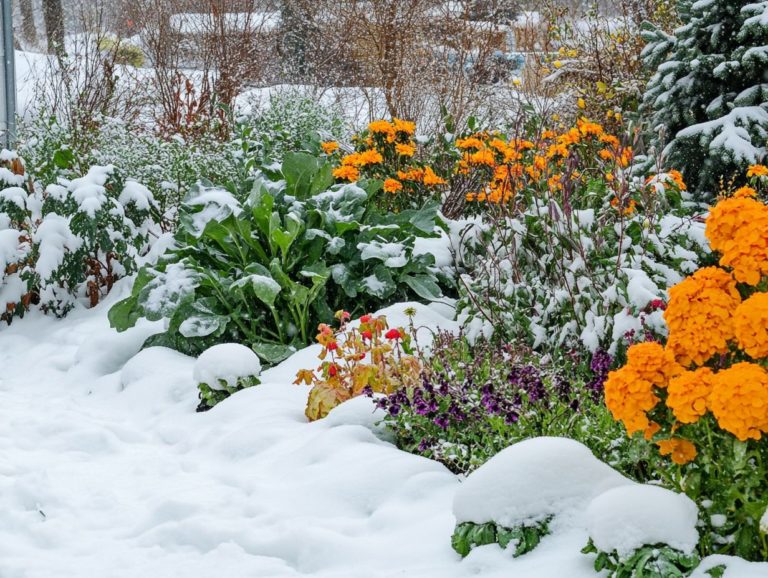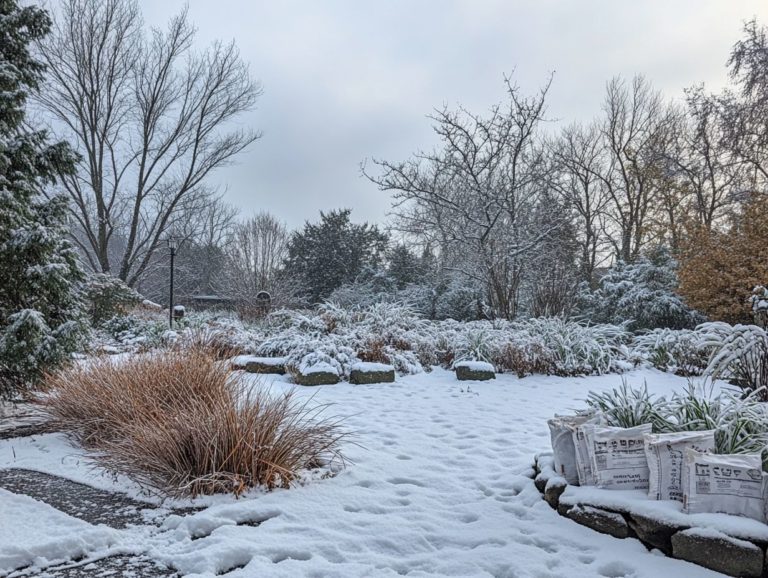How to Grow Potatoes in Cold Climates?
Growing potatoes in cold climates may seem daunting. However, with the right insights, it can be a rewarding pursuit.
This article explores the best potato varieties that thrive in cooler conditions. It also covers essential soil preparation techniques.
Discover the best times and methods for planting in chilly weather. Effective care practices for watering, fertilizing, and pest control are also included.
Learn powerful strategies for harvesting and storing your potatoes. This will help you ensure a bountiful and delicious yield.
Dive in and unlock the secrets of successful potato cultivation in cold climates!
Contents
- Key Takeaways:
- Choosing the Right Potato Varieties
- Preparing the Soil for Cold Climate Potato Growing
- Planting Potatoes in Cold Climates
- Caring for Cold Climate Potatoes
- Harvesting and Storing Cold Climate Potatoes
- Frequently Asked Questions
- What is the best time to plant potatoes in cold climates?
- Do potatoes need a lot of sunlight to grow in cold climates?
- Can potatoes be grown in containers in cold climates?
- How can I protect my potato plants from frost in cold climates?
- What type of soil is best for growing potatoes in cold climates?
- Do I need to water my potato plants more frequently in cold climates?
Key Takeaways:
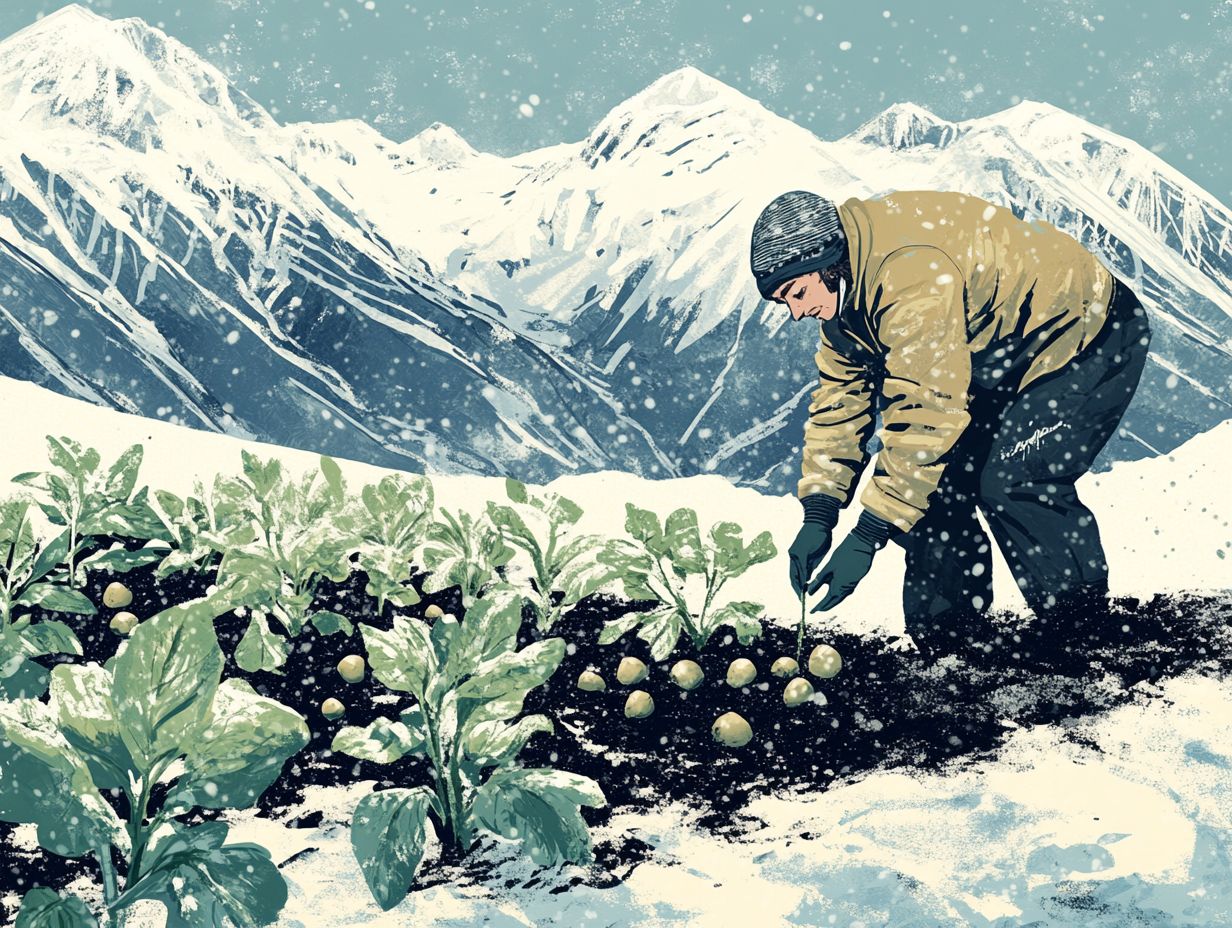
- Choose cold-climate potato varieties like Yukon Gold or Red Pontiac.
- Prepare the soil by adding organic matter and ensuring proper drainage.
- Timing is crucial: wait until the soil reaches at least 50 F for planting.
Why Grow Potatoes in Cold Climates?
Growing potatoes in cold climates is not only feasible; it’s a smart choice to maximize your yields. In regions like Alaska and other subarctic areas, the unique climate actually supports various potato varieties, especially in summer. To learn more about this, check out our guide on how to plan a cold-climate vegetable garden.
Using different planting methods and selecting the right seed potatoes enhances soil health. This approach can significantly boost your potato production.
The cooler temperatures help keep certain pests and diseases at bay. Hardy varieties like Yukon Gold and Red Norland can tolerate frost and grow robust tubers despite short growing seasons.
Implementing sustainable practices enriches the soil and reduces nutrient depletion. This fosters a productive land for future generations.
Choosing the Right Potato Varieties
Selecting the right potato varieties is vital for a successful harvest, particularly in colder climates. To enhance your gardening success, consider knowing what vegetables grow best in cold climates and choose varieties that resist frost and thrive in lower temperatures.
Opt for varieties like Yukon Gold and Kennebec, which have proven successful in cold regions. They significantly increase your chances of a fruitful harvest.
Types of Potatoes that Thrive in Cold Climates
Many types of potatoes do well in cold climates. Each variety brings unique flavors and textures to your meals.
Consider Red Pontiac, known for its versatility, or fingerling potatoes that add gourmet flair to dishes. Their frost resistance makes them ideal for early planting and late harvesting.
Yukon Gold is favored for its creamy flavor and golden skin, perfect for mashing and roasting. German Butterball potatoes are rich in taste, ideal for baking or frying. Purple Majesty adds color and antioxidants to your meals.
While planting, focus on well-drained, organic-rich soil. Mulching helps maintain soil temperature and moisture, boosting the yield and quality of your harvest.
Preparing the Soil for Cold Climate Potato Growing
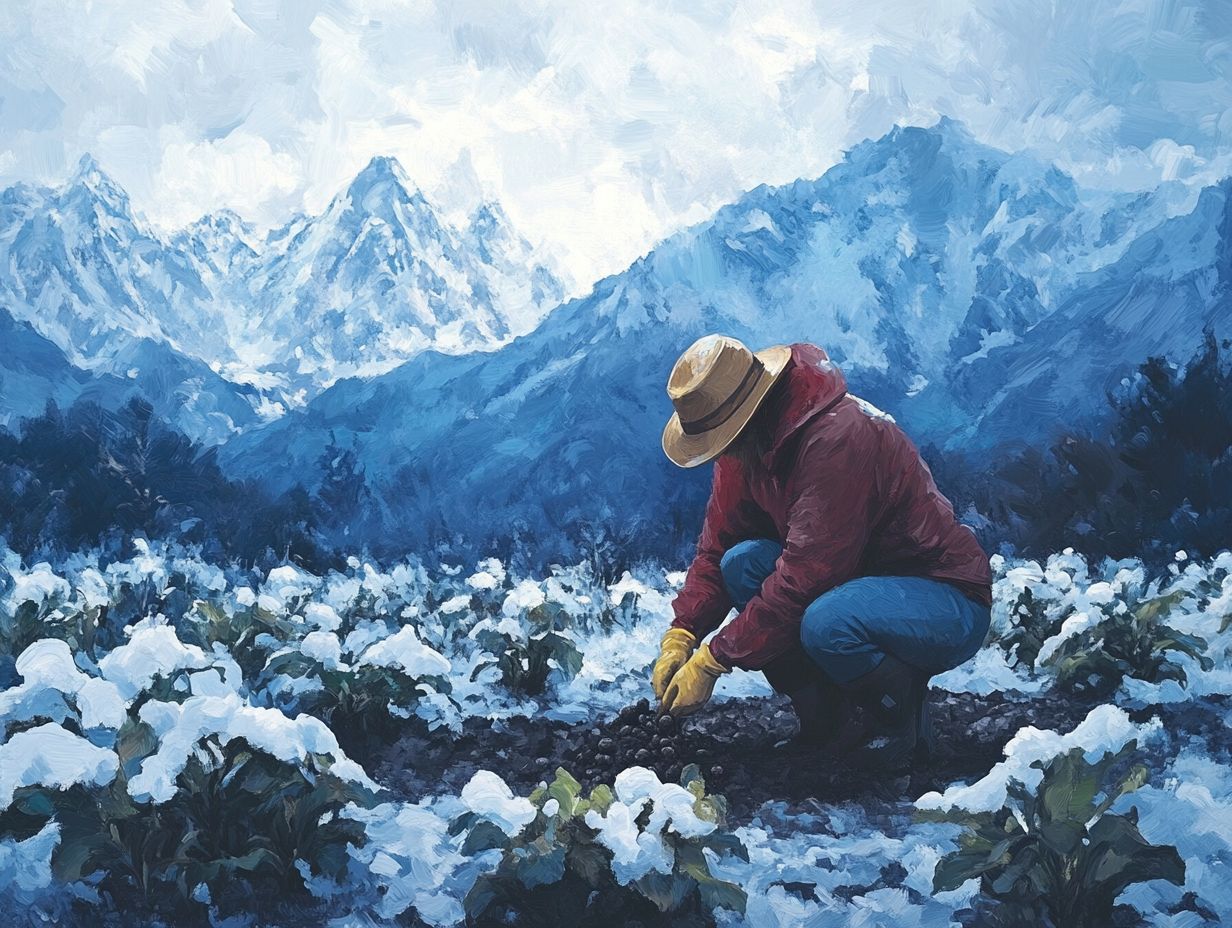
Getting your soil ready for growing potatoes in cold climates is the first step toward a bountiful harvest! Ensuring the right soil conditions, such as proper drainage and pH levels, is key to your crop’s success. For those interested in expanding their gardening skills, learning how to grow salad greens in cold climates can also be beneficial.
By incorporating organic matter like compost, you enrich the soil s nutrition. A balanced fertilizer will supply essential nutrients needed for vigorous potato plants. Taking the time to check your soil before planting will guide you in identifying the specific amendments needed to cultivate an ideal environment for robust root development.
Best Soil Conditions and Preparation Techniques
The ideal soil conditions for planting potatoes require loose, well-draining soil that promotes proper root development while minimizing the risk of rot. Techniques like double digging digging deeper than usual to aerate the soil and incorporating organic matter can significantly enhance soil structure and fertility. This ensures that your potato plants receive the nutrition they need throughout their growing cycle. Embracing crop rotation also improves soil conditions by disrupting pest and disease cycles, ultimately leading to healthier potato yields.
This textured soil should ideally feature a blend of sand, silt, and clay, which encourages aeration and prevents compaction. Aim for a pH level between 5.5 and 6.5, as this range allows for optimal nutrient availability.
Before you plant, it s wise to check the soil for nutrient levels. Adding amendments like compost or well-rotted manure will boost organic content. Incorporate cover crops during the off-season to improve soil structure and provide essential nutrients, making your subsequent potato crops more robust.
By adopting these practices, you not only optimize conditions for potato cultivation but also foster a more sustainable approach to farming.
Planting Potatoes in Cold Climates
Planting potatoes in cold climates demands a strategic approach to navigate the challenges of low temperatures and ensure a fruitful harvest. For those interested in maximizing their gardening potential, learning how to use greenhouses for cold-climate gardening can be invaluable. The optimal time for planting typically occurs when soil temperatures hover around 45 F, which usually falls between January 18th and May 4th, depending on your specific region.
To enhance your chances of a bountiful yield, it s crucial to ensure that your seed potatoes exhibit healthy eye growth prior to planting. Additionally, employing techniques like trenching digging a small ditch around your plants to protect them from cold can serve as a safeguard against those pesky late frosts in the spring.
Timing and Techniques for Planting in Cold Weather
Timing is of the essence when it comes to planting potatoes in cold weather, as frost exposure can significantly affect both yields and growth. Aim to plant your seed potatoes after the last frost date in your region, which usually falls between late April and early May.
Along with hilling mounding soil around the base of your plants for insulation consider using protective covers like floating row covers. These can safeguard your young potato plants from unexpected temperature drops. You might also think about starting your seed potatoes indoors in containers, allowing them to establish robust roots before making their grand entrance outside.
Utilizing soil thermometers to keep an eye on ground temperatures can offer valuable insights, helping you determine the best time for planting. Moreover, incorporating compost into your soil will enhance aeration and moisture retention, promoting a faster growth cycle that enables your plants to thrive even under challenging conditions.
Caring for Cold Climate Potatoes
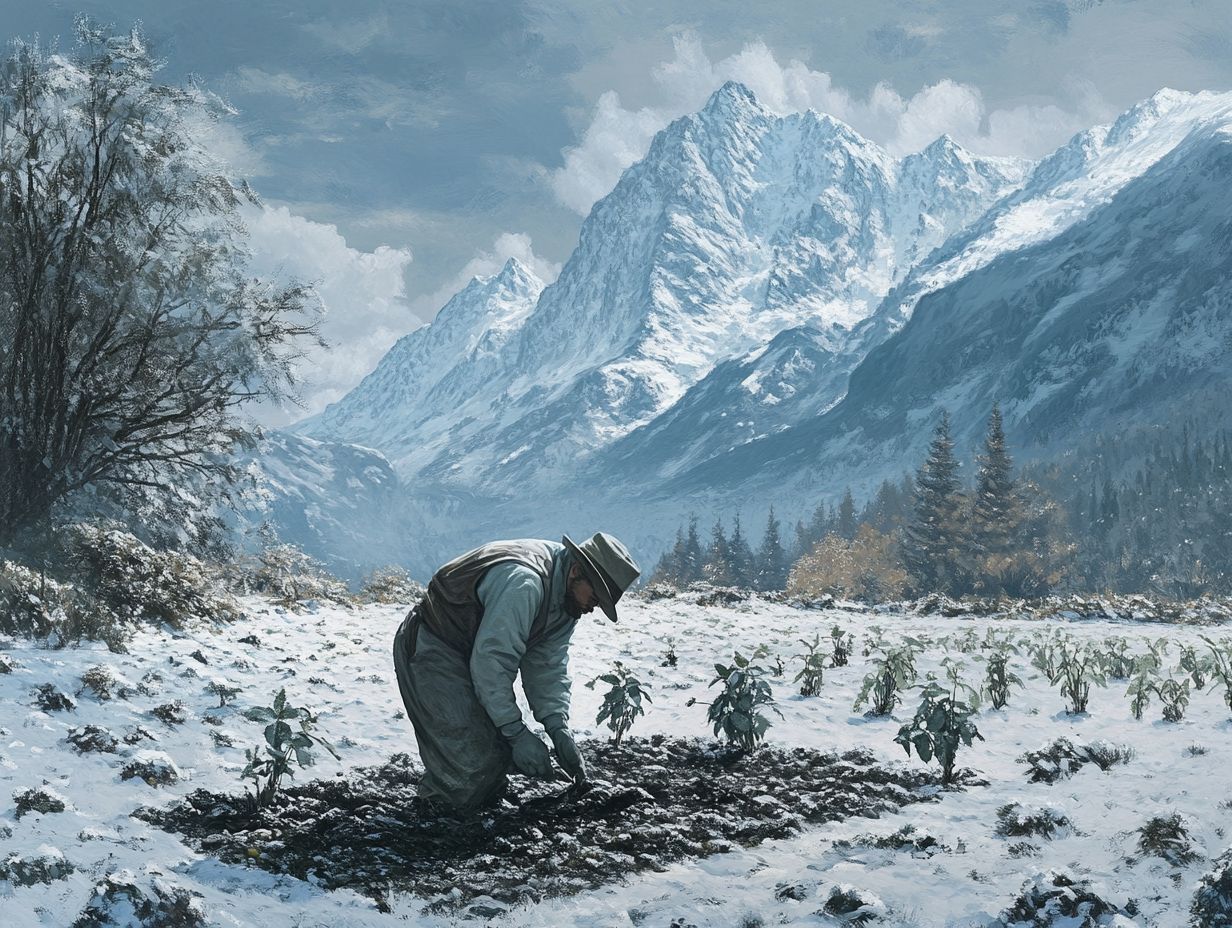
Caring for cold climate potatoes requires your diligent attention to watering, fertilizing, and pest control practices, all of which are vital for nurturing healthy potato plants throughout their growth cycle.
Regular watering is essential to maintain moist soil, especially during dry spells. A well-balanced fertilization schedule is crucial for optimal nutrient uptake and enhancing yields.
Furthermore, implementing effective pest control measures will shield your crop from potential threats, paving the way for a successful harvest.
Get started today and watch your potato plants thrive even in the cold!
Watering, Fertilizing, and Pest Control
Effective watering, fertilizing, and pest control are fundamental to growing potatoes that flourish in cold climates. Regular watering is key for maintaining adequate soil moisture, essential for nutrient absorption and preventing stress during growth.
Fertilizing with organic compost and fertilizers that provide nitrogen, phosphorus, and potassium enhances the soil’s nutrition. Timely pest control measures can effectively mitigate damage from common potato pests like aphids and Colorado potato beetles.
In colder regions, adjust your watering schedules to avoid waterlogging, which can lead to root rot. Mulching around the plants retains moisture while insulating the soil against temperature fluctuations.
Apply a balanced fertilizer at planting to enhance growth. A side dressing during the growing season ensures your potato plants receive the essential nutrients they need.
For pest management, consider implementing crop rotation and introducing beneficial insects as effective strategies to keep pest populations in check. Regular monitoring of your plants for early signs of infestations is crucial; quick intervention can save you from more severe damage.
By understanding and applying these practices, you can ensure robust potato growth and maximize yields. To know the optimal time for planting, check out when you should start planting in cold climates, even in the challenging conditions of colder climates.
Harvesting and Storing Cold Climate Potatoes
Harvesting and storing cold climate potatoes demands your attention to timing and technique to achieve optimal yields and maintain quality. The perfect moment to pluck those potatoes is when the foliage starts to yellow and die back, signaling that the tubers have reached maturity and are ready for digging.
Once you ve harvested, don t overlook the curing process. This step is crucial for healing any wounds and extending the storage life of your potatoes. Store them in a cool, dark, and dry environment to keep sprouting and decay at bay.
When and How to Harvest, and Best Storage Methods
Knowing when and how to harvest your potatoes is key to ensuring their quality and longevity. Aim to dig them up once they’ve reached full size and the tops of the plants have begun to wither typically around late summer or early fall.
For optimal storage, cure your freshly harvested potatoes in a dark, ventilated space for a couple of weeks; this can greatly extend their shelf life and preserve that delightful flavor.
Time your harvesting just before the first frost, as this can impact both the quality and taste of your potatoes. When digging them up, use a spading fork or a shovel to gently lift the tubers from the soil to avoid any unsightly bruising.
After you’ve harvested, allow your potatoes to cure. This step is crucial as it toughens the skin and prevents moisture loss, keeping them firm and flavorful. For proper storage, place them in a cool, dark area, ideally between 40-50 F, and use burlap or paper sacks to promote airflow. This simple method will help keep your potatoes fresh for several months.
Frequently Asked Questions
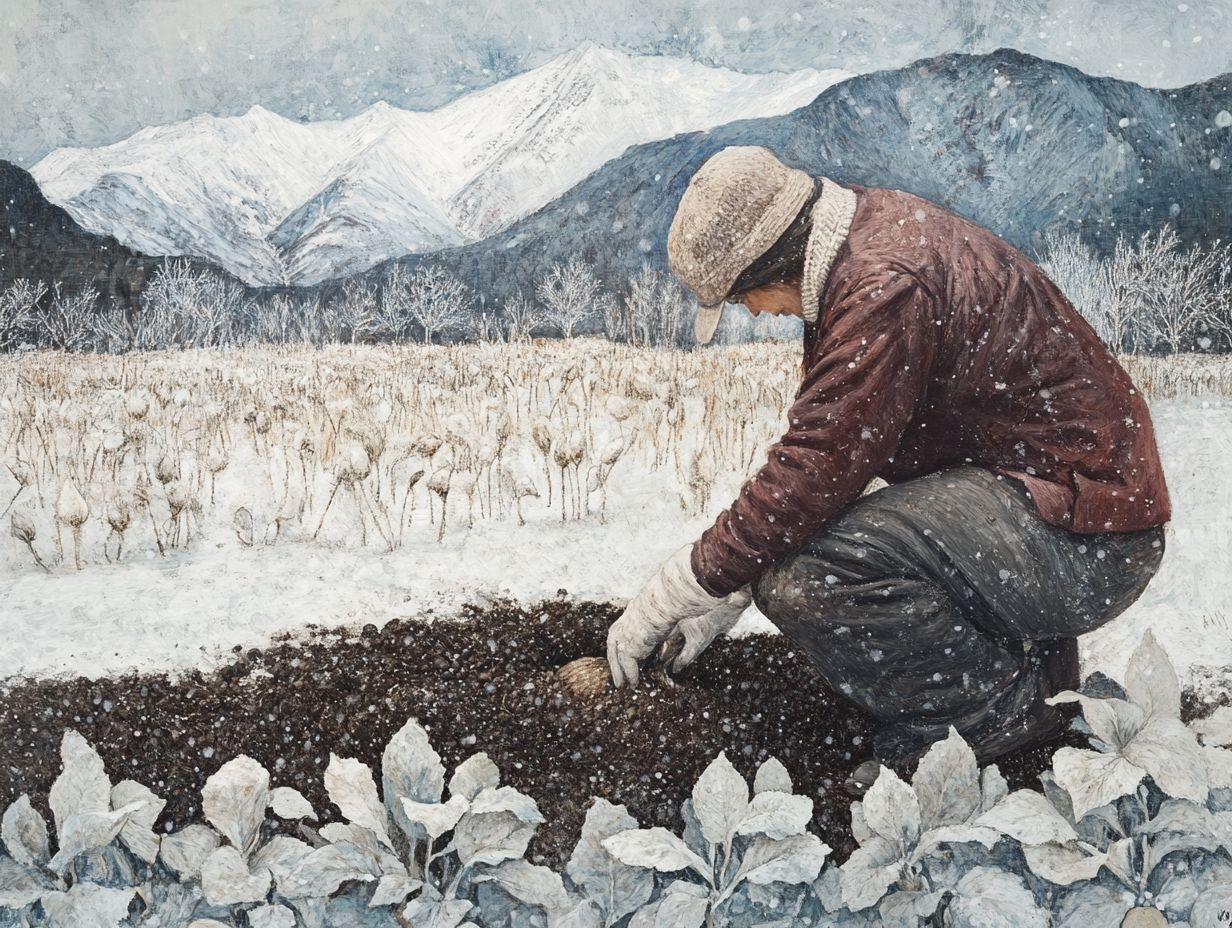
What is the best time to plant potatoes in cold climates?
The best time to plant potatoes in cold climates is in early spring, around May 4th, when the soil has thawed and the temperature is consistently above freezing.
Do potatoes need a lot of sunlight to grow in cold climates?
Yes, potatoes do need a lot of sunlight to grow. In cold climates, it is important to choose a planting location that receives at least 6 hours of direct sunlight per day.
Can potatoes be grown in containers in cold climates?
Yes, potatoes can be grown in containers in cold climates. This allows for easier control of soil temperature and moisture levels, which is important for successful growth. For more information on this, check out how to start a cold-climate garden.
How can I protect my potato plants from frost in cold climates?
To protect your potato plants from frost in cold climates, you can cover them with a layer of mulch or a frost blanket. This will help insulate the plants and protect them from freezing temperatures.
What type of soil is best for growing potatoes in cold climates?
Potatoes grow best in rich, crumbly soil with a pH level of 5.0-6.0. It’s crucial to choose a spot where the soil warms up quickly in spring to encourage healthy growth.
Do I need to water my potato plants more frequently in cold climates?
In cold climates, you don’t need to water your potato plants more often. Be careful! Overwatering can cause your potatoes to rot.
Water your plants once a week or when the soil feels dry to the touch. This way, you’ll keep your potatoes thriving!


